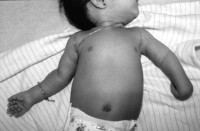Brachial Plexus, Erb’s Palsy & Klumpke’s Palsy
Birth injuries, by nature, are difficult to process because they take so little to occur; one second too long or one half-inch in the wrong direction can cause significant damage to a mother or child. Nowhere is this more apparent than when dealing with nerve injuries, or palsies. Some are more common than others, and as such, are more often the subject of lawsuits.
Brachial Plexus Injuries
Brachial plexus injuries (BPIs) are a common birth malady, and a good-sized portion of birth injury and medical malpractice lawsuits result from their occurrence. The brachial plexus is a network of nerves stemming from the spine, and given their relatively exposed position around the spinal cord, it is unfortunately all too easy to injure or shock any or all of the nerves.
While there are myriad reasons for BPIs, the most talked-about is the obstetric BPI, which usually happens when, during delivery, the baby experiences shoulder dystocia (where it is awkwardly positioned and its shoulders stick in the birth canal). BPIs are usually measured by their severity, which ranges from mild shocks to complete tearing of the nerve. Injuries to differing areas of the nerve network are given different names, and tend to exhibit different symptoms.
Erb’s Palsy & Klumpke’s Palsy
 The two most common obstetric BPIs are Erb’s and Klumpke’s palsies, named for their discoverers. Children diagnosed with either make up a significant proportion of birth injury lawsuits, because it can be very easy to miss the signs, and the condition can set in with little to no warning.
The two most common obstetric BPIs are Erb’s and Klumpke’s palsies, named for their discoverers. Children diagnosed with either make up a significant proportion of birth injury lawsuits, because it can be very easy to miss the signs, and the condition can set in with little to no warning.
Erb’s palsy is the name given to an injury sustained in the upper area of the brachial plexus. It most often leads to difficulties in moving one’s shoulder and elbow, and may be mild or severe. It only occurs in approximately 1-2 babies per 1000, but when it does occur, it can be due to medical negligence. If a BPI affects both the upper and lower regions of the brachial plexus, it encompasses more than would normally be called Erb’s palsy, and is usually called a ‘universal’ or ‘global’ BPI. Erb’s, however, is in the upper quadrant only.
Klumpke’s palsy, as one might assume, is the name for an injury in the lower half of the brachial plexus network. It affects the hand and forearm most commonly, sometimes giving rise to an appearance of one hand being gnarled or clawed.
Both of these maladies have the possibility of a full recovery. However, depending on the severity of the nerve damage (the most severe is called an avulsion, and it is a complete tear of the nerve away from the root), some may not be reparable unless immediate surgical attention is provided. Failure to do so may be grounds to allege a failure of care.
Contact A Birth Injury Attorney
If your child has sustained a BPI due to medical negligence, we can help. The attorneys at Meinhart & Manning, PLLC have a long history of success in medical malpractice and other negligence cases, and we will put the lessons we have learned to work for you. Contact our Louisville office today for a free consultation.
Related Articles